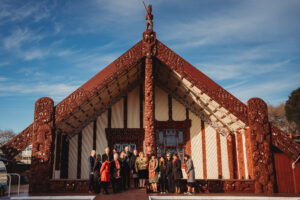
Embarking on a project to make aged care more accessible led Member Norah Barlow, Chief Executive Officer of Heritage Lifecare, along with her team, through a journey of embracing te ao Māori.
The newly-launched Kaupapa Māori strategy marks a refreshed approach to aged care — and acts as an example for holistic co-creation, collaboration, and equitably-focused, ground-root problem solving for many organisations.
Global Women joined in exclusive kōrero with Norah to hear more insights on the Kaupapa Māori strategy; why widespread collaboration is key to equitable outcomes, how to reflect your community, and how the strategy carries on beyond caring for just the aged care clientele.
“The strategy involves expanding awareness of Te Reo Māori and Tikanga, creating partnerships within our communities, and growing the pathways for Māori into aged care careers” —Norah Barlow
What is your Kaupapa Māori Strategy, and what does it look like?
“The Kaupapa Māori strategy was developed and implemented at Cantabria Lifecare, our Care Home in Rotorua, to support our kaumātua, their whānau and communities, by providing a Care Home that is an inclusive environment, upholding Te Tiriti o Waitangi (The Treaty of Waitangi). The strategy involves expanding awareness of Te Reo Māori and Tikanga, creating partnerships within our communities, and growing the pathways for Māori into aged care careers. Mariana Morrison, our Head of Cultural partnerships, led the Cantabria strategy and is leading the implementation of the strategy to our other 41 homes across New Zealand, from Invercargill to Whangarei,” shares Norah.
The The Kaupapa Māori strategy was launched on the eve of Matariki in Rotorua. It is supported by the Cantabria Māori Network Committee who are responsible for implementing and promoting Te Reo Maori strategies, such as bilingual signage, menus, increasing Te Reo Māori in daily staff and resident activities, teaching Tikanga. A designated cultural room has been created at Cantabria to be used for Whakatau (welcome ceremonies), performances, hui with whānau, displaying Māori arts and crafts, and an area for all cultures to use and enjoy.
Moreover, this approach of embracing te ao has extended far beyond the facilities themselves: an important initiative in the Kaupapa Māori strategy is to partner with education providers to encourage more Māori to choose aged care as a career, supporting with education.
Why was it important for you to make care more equitable?
Our goal is to improve health outcomes for older people. It is important that all older people in New Zealand receive equitable access to the aged care services they need, removing any barriers. This is particularly important with an ageing population and increasing trends in the industry to charge premiums for the shortfall in Government funding. I want everyone who needs it, to have equitable access to aged care, so it does not become the domain of only those who can afford it.
“We are proud of Cantabria and the Rotorua community for being trailblazers in aged care health initiatives to support Māori” —Norah Barlow
What are you most proud of in creating the Kaupapa Māori Strategy?
The Kaupapa Māori strategy is a first for New Zealand aged care. We are proud of Cantabria and the Rotorua community for being trailblazers in aged care health initiatives to support Māori and be inclusive of all cultures.
What principles and values guided the creation of the Kaupapa Māori Strategy?
The Kaupapa Māori strategy reflects the residents who chose us, the local communities that surround us, and the wonderful people that work with us.
Our Heritage Lifecare values are embedded the strategy; People First (Kia tika te rere o te waka), Nurturing Success (Poipoia te angitu) and Better together (He toa takitini).
The principles that guide the strategy are based on partnership and whanaungatanga (a connection between people) and a commitment that we at Heritage Lifecare uphold the principles of Te Tiriti o Waitangi. The principle of equity for all people, underpins the strategy, and this is critical in aged care.
“This aged care strategy was a whole-of-community approach… including local Iwi, DHB, education providers, social services, whānau and local council” —Norah Barlow
Were there any interesting learnings that cropped up while working on this?
An important learning was that this aged care strategy was a whole of community approach, led by our team at Cantabria. We had fantastic community involvement, including local Iwi, DHB, education providers, social services, whānau and local council. At the launch of the strategy, we all celebrated by opening a cultural room and unveiling a commissioned mural. Many members of the local community attended, including the mayor. It was a special day.
This strategy aligns with the implementation of the Government’s Ngā Paerewa Health and Disability Service Standards – a shift towards a more person and whānau centred health and disability service.
It’s clear that collaboration to create this strategy is already off to a promising start: “it has been a community approach, and we have been overwhelmed with the support from the community.”
